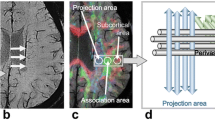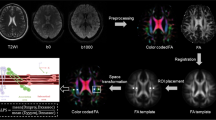Abstract
Quinolinic acid, an excitotoxic agent, was applied unilaterally to the nucleus basalis magnocellularis of the rat forebrain, which resulted in neuronal destructions and consequently, loss of cholinergic projections to the cortex. The effects on ganglioside metabolism in brain cortical matter were studied. Total ganglioside contents in lesioned brains (n=8) were found to be significantly decreased (range, 20–60%) but changes in brain ganglioside patterns on thin layer chromatograms were not apparent. On the other hand, in vivo incorporation ofN-acetyl-d-[U-14C]mannosamine into brain gangliosides ranged from 19 to 36% (mean, 26%) of radiolabel in controls, and 5 to 21% (mean, 13%), a significant reduction in lesioned brains. Labeling of brain glycoproteins or of nonganglioside lipids was not affected. Since central cholinergic hypofunctions are also important neurochemical characteristics of Alzheimer’s disease, abnormal ganglioside metabolism found in the lesioned rats may be of significance in the human disorder, where reduced brain ganglioside contents have also been reported.
Similar content being viewed by others
References
Caputto B. L., Noves G. A., Cemborain B. N., and Caputto R. (1982) The effect of light exposure following an intraocular injection ofN-[3H]-acetylmannosamine on the labeling of gangliosides and glycoproteins.Brain Res. 245, 231–238.
Coyle J. T., Price D. L., and Delong M. R. (1983) Alzheimer’s disease: A disorder of cortical cholinergic innervation.Science 219, 1184–1190.
Cuello A. C., Stephens P. H., Tagari P. C., Sofroniew M. V., and Pearson R. C. (1986) Retrograde changes in the nucleus basalis of the rat, caused by cortical damage, are prevented by exogenous ganglioside GM1.Brain Res. 376, 373–377.
Derrington E. A., Masco D., Whittaker V. P. (1989) Confirmation of the cholinergic specificity of the chol-1 gangliosides in mammalian brain using affinity-purified antisera and lesions affecting the cholinergic input to the hippocampus.J. Neurochem. 53, 1686–1692.
El-Defrawi S. R., Coloma F., Jhamandas K., Boegman R. J., Beninger R. J., and Wirsching B. A. (1985) Functional and neurochemical cortical cholinergic impairment following neurotoxic lesions of the nucleus basalis magnocellularis in the rat.Neurobiol. Aging 6, 325–330.
Favaron M., Manev H., Alho H., Bertolini M., Ferret B., Guidotti A., and Costa E. (1988) Gangliosides prevent glutamate and kainate neurotoxicity in primary neuronal cultures of neonatal rat cerebellum and cortex.Proc. Natl. Acad. Sci. 85, 7351–7355.
Ferretti P. and Borroni E. (1986) Putative cholinergic-specific gangliosides in guinea-pig forebrain.J. Neurochem. 46, 1888–1894.
Folch J., Lees M., and Sloane Stanley G. H. (1957) A simple method for the isolation and purification of total lipidis from animal tissue.J. Biol. Chem. 226, 497–509.
Johnston M. V., McKinney M., and Coyle J. T. (1979) Evidence for a cholinergic projection to the neocortex from neurons in the basal forebrain.Proc. Natl. Acad. Sci. 76, 5392–5396.
Jonsson G., Gorio A., Hallman H., Janigro F., Kojima H., Luthman J., and Zanoni R (1984). Effects of GM1 ganglioside in developing and mature serotonin and noradrenalin neurons lesioned by selective neurotoxins.J. Neurosci. Res. 12, 459–475.
Ledeen R. W., Haley J. E., and Srivanek J. A. (1981) Study of ganglioside patterns with two-dimensional thin-layer chromatography and radioautography; Detection of new futogangliosides and other minor species in rabbit brain.Anal. Biochem. 112, 135–142.
Ledeen R. W. and Yu R. K. (1982) Ganglioside structure isolation and analysis, inMethods in Enzymology (Ginsburg V., ed.)83, Academic, New York, pp. 139–191.
Lehman J., Nagy J. I., Atmodja S., and Fibiger H. C. (1980) The nucleus basalis magnocellularis: the origin of cholinergic projection to the neocortex of rat.Neuroscience 5, 1161–1174.
Miettinen T. and Takki-Luukkainen C. T. (1959) Use of butylacetate in the determination of sialic acid.Acta Chem. Scand. 13, 856–858.
Ng Ying Kin N. M. K., Pan L. H., and Louvaris J. H., Robitaille Y., and Nair N. P. V. (1989) Brain gangliosides in Alzheimer’s disease and in rats with forebrain lesions.Soc. NeuroSci. Abs. 15(1), 859.
Pedata F., Giovanelli L., and Pepeu G. (1984) GM1 ganglioside facilitates the recovery of high-affinity choline uptake in the cerebral cortex of rats with a lesion of the nucleus basalis magnocellularis.J. Neurosci. Res. 12, 421–427.
Schwarcz R., Whetsell W. O., and Mangano R. M. (1983) Quinolinic acid: An endogenous metabolite that produces axon-sparing lesions in rat brain.Science 219, 316–318.
Sorbi S., Piacentini S., and Amaducci L. (1987) Intralaminar distribution of neurotransmitter-related enzymes in cerebral cortex of Alzheimer’s disease.Gerontology 33, 197–202.
Svennerholm L. (1957) Quantitative estimation of sialic acids.Biochim. Biophys. Acta 24, 604–611.
Toffano G., Savoini G., Mroni F., Lombardi G., Calza L., and Agnati L. F. (1983) GM1 ganglioside stimulates the regeneration of dopaminergic neurons in the central nervous system.Brain Res. 261, 163–166.
Author information
Authors and Affiliations
Rights and permissions
About this article
Cite this article
Ng Ying Kin, N.M.K., Chung, D. In vivo incorporation ofN-acetyl-d-[U-14C]mannosamine into brain gangliosides of rats with quinolinic acid-induced lesions of the forebrain nucleus basalis magnocellularis. Molecular and Chemical Neuropathology 13, 233–241 (1990). https://doi.org/10.1007/BF03159926
Received:
Accepted:
Issue Date:
DOI: https://doi.org/10.1007/BF03159926




